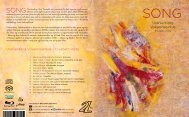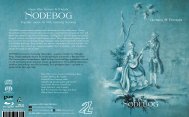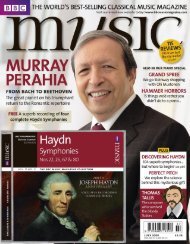You also want an ePaper? Increase the reach of your titles
YUMPU automatically turns print PDFs into web optimized ePapers that Google loves.
<strong>The</strong> <strong>Schubert</strong> <strong>Connection</strong><br />
Franz <strong>Schubert</strong> (1797–1828)<br />
String Quartet No. 14 in D minor D. 810<br />
Death and the Maiden<br />
1 Allegro 10:58<br />
2 Andante con moto 12:53<br />
3 Scherzo. Allegro molto 3:48<br />
4 Presto 9:05<br />
Edvard Grieg (1843–1907)<br />
String Quartet in G Minor Op. 27<br />
5 Un poco Andante – Allegro molto ed agitato 11:45<br />
6 Romanze. Andantino 6:23<br />
7 Intermezzo. Allegro molto marcato – Più vivo e scherzando 6:06<br />
8 Finale. Lento – Presto al Saltarello 8:56<br />
Oslo String Quartet<br />
Geir Inge Lotsberg and Liv Hilde Klokk (violins)<br />
Are Sandbakken (viola) and Øystein Sonstad (cello)<br />
<strong>The</strong> connection between Edvard Grieg’s String Quartet in G minor and Claude<br />
Debussy’s String Quartet in the same key is very well documented. On the surface,<br />
this connection might seem a little unlikely since Debussy once – a little cruelly<br />
perhaps – dismissed Grieg’s music as having the strange and delightful taste of pink<br />
candy filled with snow. But a closer look at Debussy’s own music reveals that he in fact<br />
owed more to his older colleague than he cared to admit. Both their G minor quartets<br />
not only share the same tonic key, but also the general outline of the main themes,<br />
which are thematically prominent throughout the two quartets. Thus both works<br />
are in effect cyclical, a device not so common in chamber music before Grieg’s time.<br />
<strong>The</strong>re are also, of course, many differences between these two works, but it remains<br />
fascinating to note the similarities between them.<br />
However, comparatively little (or rather, to the best of my knowledge, nothing at<br />
all) has been written on the subject of the models Grieg himself might have had for<br />
his string quartet, in terms of style, instrumentation and musical idiom. As is well<br />
known, Grieg did not consider himself a master of the big forms, and, despite such<br />
an incredibly successful work as the early Piano Concerto in A minor, history on the<br />
whole has proved him right. He even went so far as to suppress his only symphony,<br />
literally forbidding posterity to perform or hear the work. However, he never actually<br />
destroyed the manuscript and this indicates, perhaps, that he still harbored ambitions<br />
to be a symphonist.<br />
At all events, it seems reasonable to see the G minor String Quartet as an attempt by<br />
Grieg to “redeem” himself as a composer of music on a larger scale. He said that he<br />
wanted this new work to sound as big as possible for the four string instruments, and<br />
the frequent use of double stops, loud dynamics and heavy accents certainly lends to<br />
it an orchestral air. In fact more than one string orchestra has tackled the work, only<br />
adding a double bass part to the already full-bodied texture.<br />
During composition of this quartet, Grieg repeatedly met stumbling blocks in terms<br />
of difficulty of form and lack of inspiration. Much can be attributed to the fact that<br />
he was going through a particularly difficult phase in his personal life at the time, as<br />
well as suffering from one of his recurring losses of confidence. This certainly makes<br />
an imprint on the music: its sombre and troubled atmosphere makes it a somewhat<br />
problematic, even recalcitrant piece, in spite of its many passages of repose and light.<br />
— 5 —

















